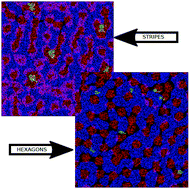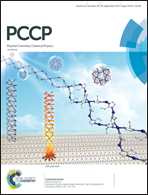Two-dimensional pattern formation in ionic liquids confined between graphene walls
Abstract
We perform molecular dynamics simulations of ionic liquids confined between graphene walls under a large variety of conditions (pure ionic liquids, mixtures with water and alcohols, mixtures with lithium salts and defective graphene walls). Our results show that the formation of striped and hexagonal patterns in the Stern layer can be considered as a general feature of ionic liquids at electrochemical interfaces, the transition between patterns being controlled by the net balance of charge in the innermost layer of adsorbed molecules. This explains previously reported experimental and computational results and, for the first time, why these pattern changes are triggered by any perturbation of the charge density at the innermost layer of the electric double layer (voltage and composition changes, and vacancies at the electrode walls, among others), which may help tuning electrode–ionic liquid interfaces. Using Monte Carlo simulations we show that such structures can be reproduced by a simple two-dimensional lattice model with only nearest-neighbour interactions, governed by highly screened ionic interactions and short-range and excluded volume interactions. We also show that the results of our simulations are consistent with those inferred from the Landau–Brazovskii theory of pattern formation in self-assembling systems. The presence of these patterns at the ionic liquid graphene–electrode interfaces may have a strong impact on the process of ionic transfer from the bulk mixtures to the electrodes, on the differential capacitance of the electrode–electrolyte double layer or on the rates of redox reactions at the electrodes, among other physicochemical properties, and is therefore an effect of great technological interest.



 Please wait while we load your content...
Please wait while we load your content...